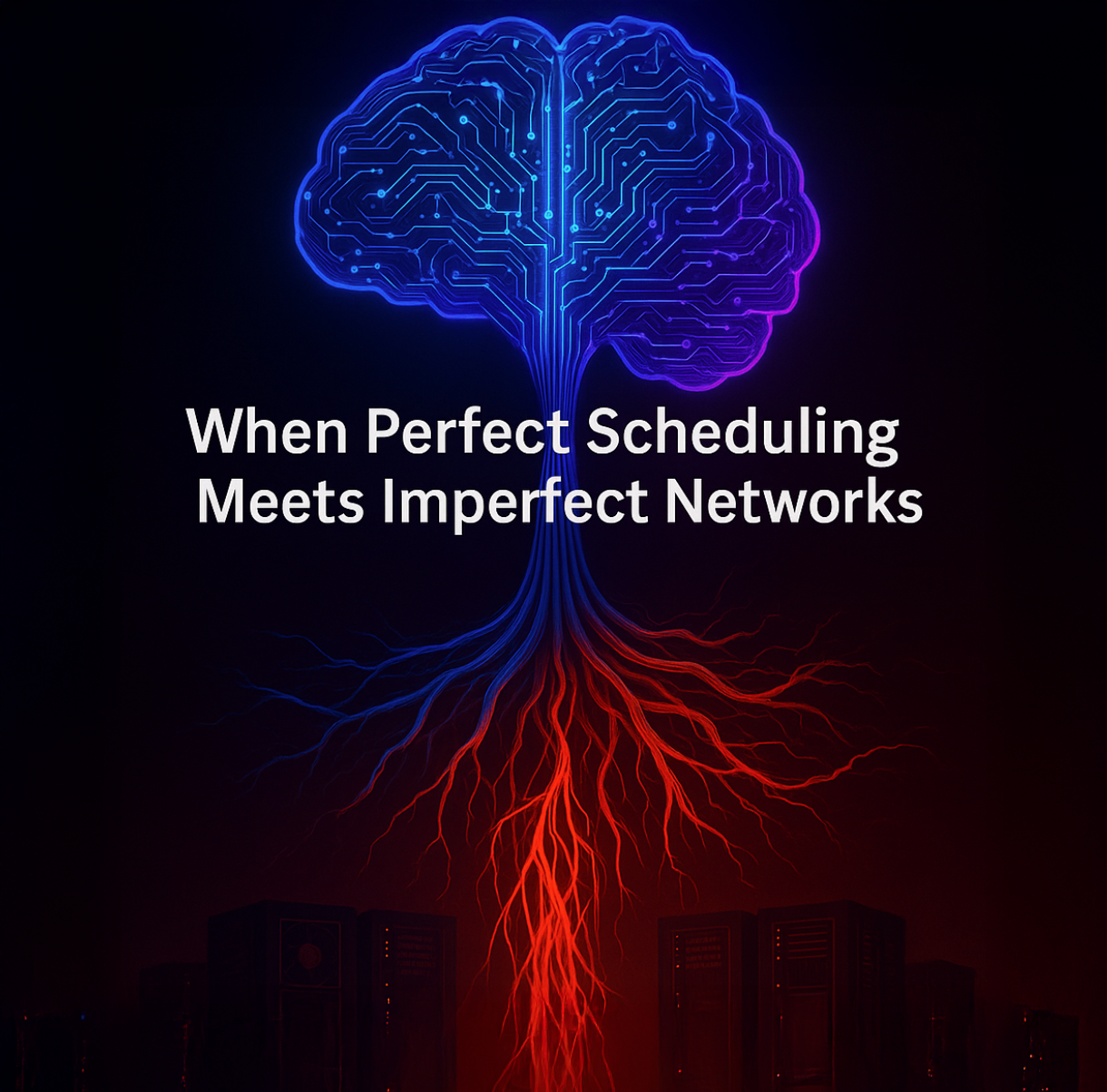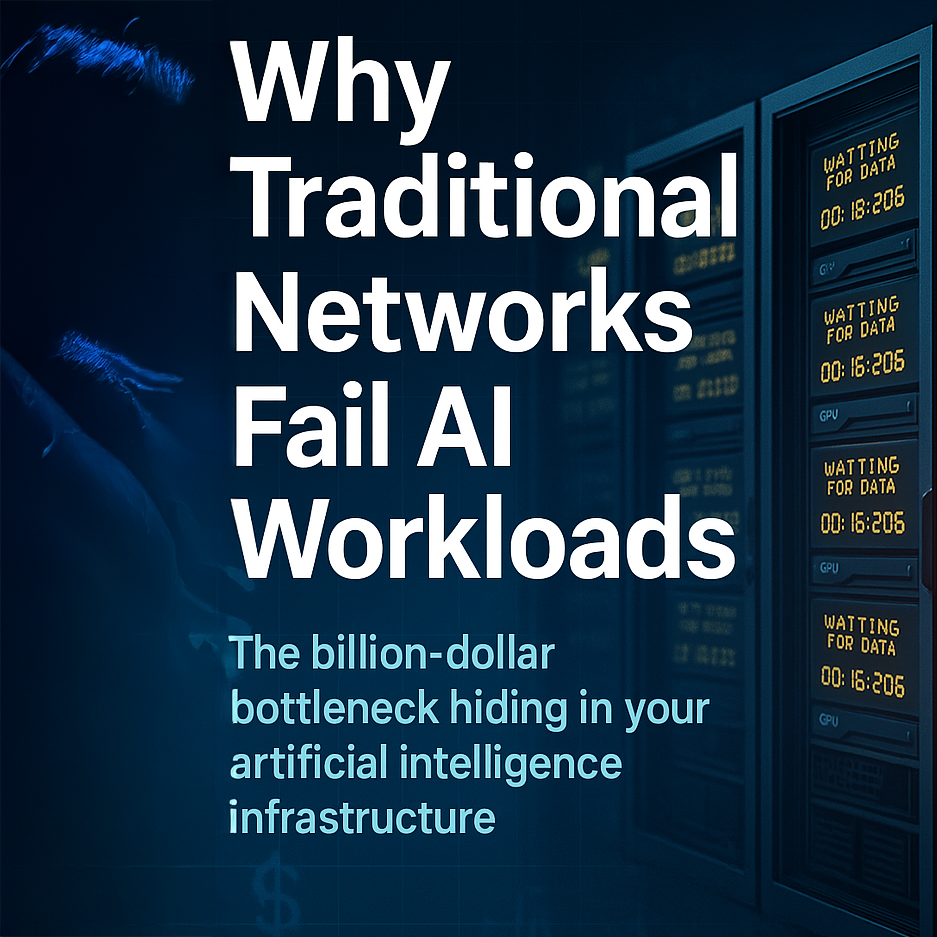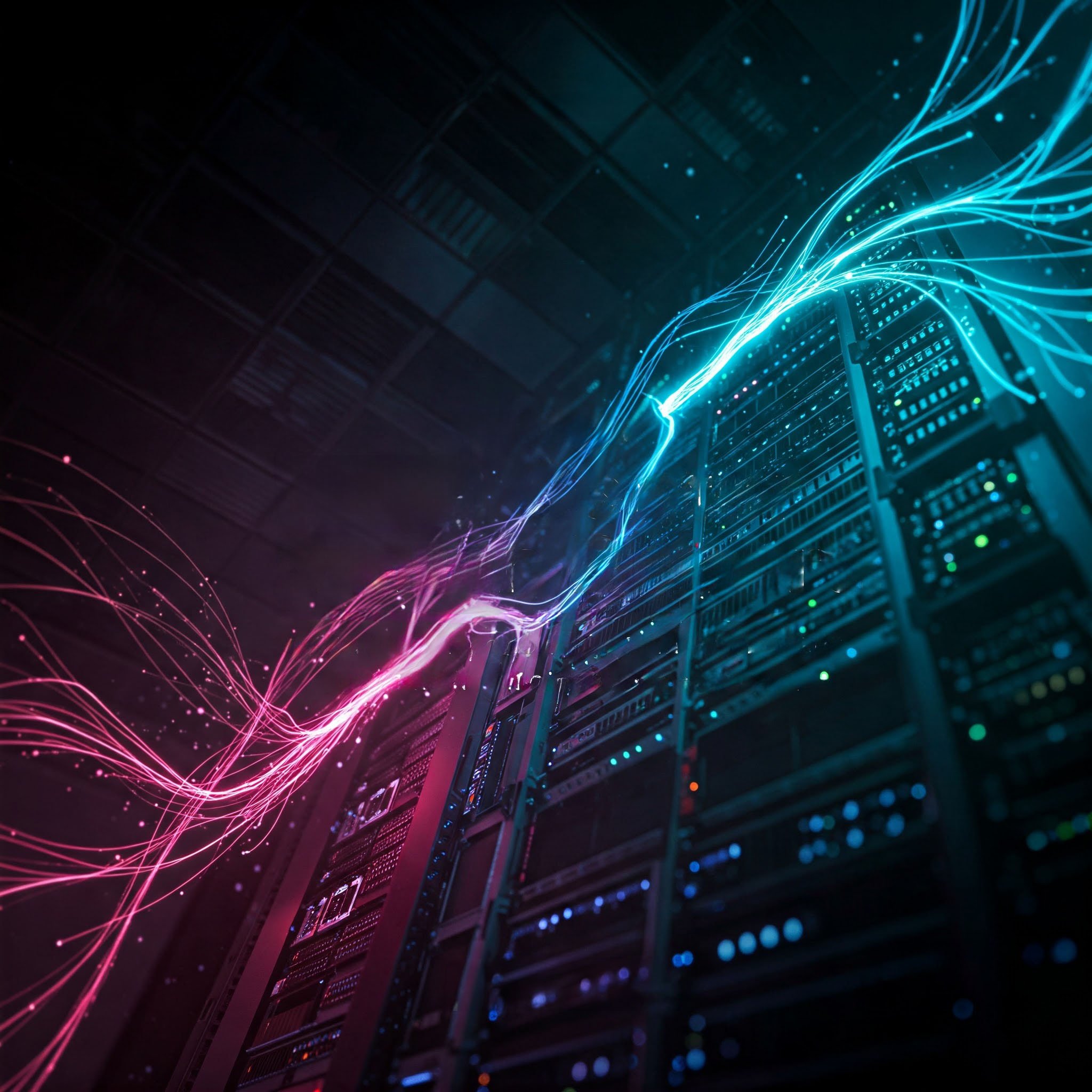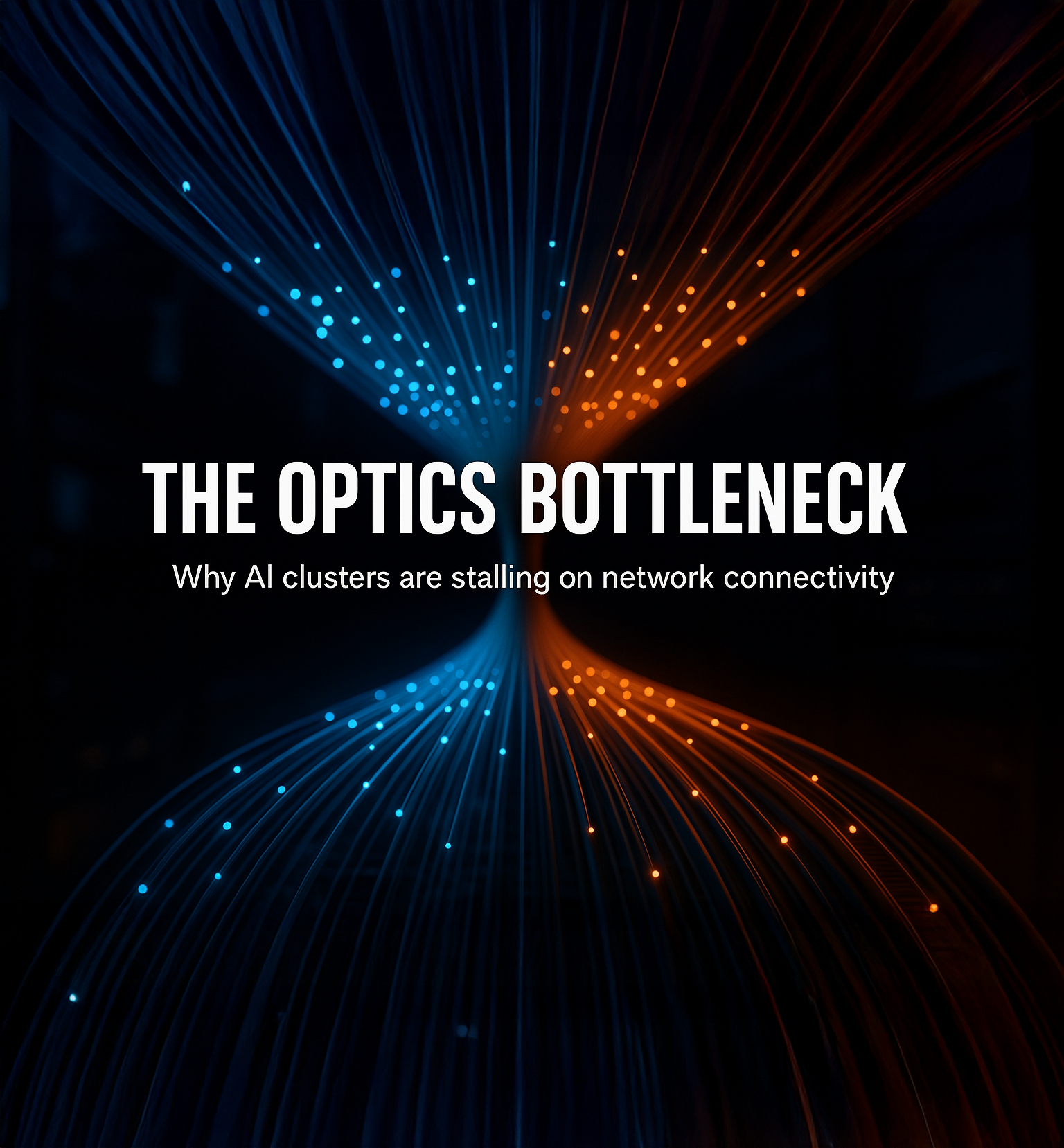Why Traditional Networks Fail AI Workloads
Why Traditional Networks Fail AI Workloads The billion-dollar bottleneck hiding in your artificial intelligence infrastructure
9 min read
![]() Art Fewell
:
Jun 12, 2025 10:29:17 AM
Art Fewell
:
Jun 12, 2025 10:29:17 AM

If you work with AI infrastructure, manage Kubernetes clusters for machine learning workloads, or evaluate scheduling solutions for GPU-based training, you've probably heard impressive claims about next-generation AI schedulers. They promise topology-aware placement, ML-powered prediction algorithms, and the ability to orchestrate tens of thousands of GPUs with surgical precision. But here's a question that doesn't get asked enough: what happens when your sophisticated scheduler makes perfect decisions that your network infrastructure simply can't support?
The reality is that sophisticated Kubernetes schedulers can make optimal placement decisions that create network conditions the underlying infrastructure simply cannot support. Understanding why this scheduling-network disconnect occurs, how to identify when it's happening in your environment, and what infrastructure changes actually solve the problem starts with a basic question that doesn't get asked enough: what does effective AI orchestration actually require from network infrastructure?
To understand why network infrastructure matters so much for Kubernetes AI scheduling, we need to understand what modern AI workloads are asking the orchestration layer to coordinate. When Kubernetes schedules traditional web applications or microservices, it's coordinating relatively independent components that communicate through well-defined APIs with predictable traffic patterns.
AI workloads are fundamentally different. Consider what happens when you submit a large-scale training job to Kubernetes. You're not just asking it to schedule some containers - you're asking it to orchestrate a distributed supercomputer that requires microsecond-precision coordination between thousands of GPUs.
Let's use a concrete example. Training a large language model typically involves data parallelism, where different GPUs process different batches of training data but must synchronize their learning after each iteration. During the computation phase, each GPU works independently and network traffic is minimal. But during synchronization, all GPUs simultaneously initiate what's called an all-reduce operation, where they combine their learning and ensure every GPU has the same updated model.
This creates a traffic pattern that traditional networks simply weren't designed to handle. Most of the time during training, each GPU processes its assigned data independently with minimal network activity. But periodically - typically every few hundred milliseconds - all GPUs need to synchronize their learning through massive, simultaneous data exchanges. Picture thousands of GPUs that have been working quietly suddenly needing to share multi-gigabyte updates with each other at exactly the same moment.
The mathematics are unforgiving. If you have 1,000 GPUs each trying to send gradient data to every other GPU simultaneously, you're looking at synchronized traffic bursts that can overwhelm even advanced switching infrastructure. No amount of intelligent scheduling can solve a fundamental bandwidth problem.
This is why your Kubernetes scheduler might be making perfect placement decisions that create impossible network conditions. The scheduler sees available GPU nodes and makes optimal choices for CPU, memory, and GPU allocation. But if those choices result in communication patterns that exceed network capacity, your expensive GPU hardware ends up waiting for data transfers to complete.
Modern Kubernetes schedulers for AI workloads have become remarkably sophisticated. NVIDIA's recently released KAI Scheduler can coordinate batch scheduling with topology awareness, ensuring all pods in a training job are scheduled simultaneously while optimizing for GPU communication requirements. Volcano excels at gang scheduling and advanced job lifecycle management. YuniKorn provides hierarchical queue management with fine-grained resource allocation.
These schedulers solve real problems that matter enormously for AI infrastructure efficiency. They can predict optimal pod placement, balance workloads across massive clusters, and ensure that expensive GPU hardware stays productive. The technical depth is genuinely impressive.
But here's where the challenge emerges: these schedulers operate under the assumption that the network can handle whatever traffic patterns their optimal placement decisions create. They focus on compute resource optimization - which GPUs are available, how much memory each node has, which nodes are in the same rack for faster communication. They don't typically understand the deeper network implications of their placement choices.
Consider what happens when KAI Scheduler makes topology-aware placement decisions for a 512-GPU training job. The scheduler identifies optimal GPU nodes and places pods to minimize NVLink hop counts and maximize theoretical communication bandwidth. From a scheduling perspective, this is perfect. But if the network fabric connecting those optimally placed nodes can't actually handle the synchronized all-reduce traffic that the training job will generate, the entire job stalls while thousands of GPUs wait for network operations to complete.
It's like having the world's most intelligent air traffic control system trying to manage an airport where the runways can't handle the aircraft volume the system is trying to coordinate. The intelligence is real, but it's constrained by infrastructure limitations that exist outside the scheduler's control.
This disconnect hit me particularly hard at the recent North American KubeCon. Session after session showcased genuinely impressive advances in Kubernetes scheduling for AI workloads. Custom schedulers promising to solve GPU idleness, ML algorithms predicting optimal pod placement, sophisticated queue management ensuring fairness and efficiency. The technical depth was remarkable.
But as I listened to these presentations, I kept wondering whether the professionals working so hard to maximize scheduling efficiency understood that their efforts could be completely undermined without the right network infrastructure. It's not that they didn't understand networking - it's that the AI infrastructure landscape has become so complex that even experts focus intensely on their specific domain while critical interdependencies get overlooked.
To understand why this scheduler-network disconnect matters, we need to examine the specific traffic patterns that AI workloads create and why they challenge traditional network designs.
The most problematic pattern is what happens during gradient synchronization in distributed training. During normal computation, GPUs work independently and generate minimal network traffic. But when it's time to synchronize learning across all GPUs in a training job, every GPU simultaneously begins transmitting large amounts of data to multiple destinations.
The challenge becomes particularly acute when multiple high-bandwidth training jobs try to use shared network resources simultaneously. Modern data center switches can handle enormous aggregate throughput, but they struggle when many senders target the same destination at once - imagine ten different 800-gigabit connections all trying to deliver data to a single server port at the same time. The receiving server's single 800-gigabit connection becomes an unavoidable bottleneck regardless of how fast the switching hardware operates.
Conventional data center networks were built assuming workloads would generate diverse, asynchronous traffic patterns spread across many independent applications. Individual connections typically required moderate bandwidth with tolerance for variable latency, and network load would distribute statistically across the infrastructure over time. Network infrastructure was optimized for statistical load distribution across many independent flows.
AI workloads demand the opposite: enormous bandwidth requirements with strict timing constraints and perfectly synchronized communication phases. When advanced Kubernetes schedulers optimize AI workload placement for compute efficiency, they often inadvertently create these synchronized network demands without considering whether the underlying infrastructure can support them.
The timing sensitivity makes these challenges even more difficult. Unlike traditional applications that can tolerate variable network latency, distributed training requires predictable, low-latency communication to keep expensive GPU hardware fully utilized. When network congestion causes delays in collective operations, the entire training job stalls while thousands of GPUs wait for communication to complete.
The solution isn't to abandon sophisticated scheduling - these innovations solve real problems and deliver genuine value when implemented properly. Instead, the solution is ensuring that scheduling innovations are built on network infrastructure designed for AI workloads.
This requires understanding the fundamental architectural differences between traditional enterprise networks and AI-optimized fabrics. The most critical distinction is between endpoint-scheduled and switch-scheduled approaches to traffic management.
Traditional switch-scheduled fabrics use deep buffers to centrally manage traffic flow. While these systems can provide sophisticated traffic scheduling, they introduce significant latency overhead as packets traverse multiple buffer stages, and centralized scheduling logic becomes a bottleneck at the massive scales that AI workloads demand.
Endpoint-scheduled fabrics take a different approach, distributing scheduling intelligence to the endpoints themselves. This enables distributed coordination that can handle AI traffic patterns more effectively. Rather than requiring centralized switches to manage complex traffic flows, intelligent endpoints coordinate directly with each other to optimize communication patterns.
This architectural difference is central to the newly released Ultra Ethernet 1.0 specification, which provides standardized approaches to handling AI communication patterns efficiently. Ultra Ethernet introduces ephemeral connections that eliminate handshake delays, standardized support for in-network collectives where switches can participate directly in operations like all-reduce, and APIs for endpoint-based congestion control that enable training software to coordinate directly with network infrastructure.
The scale capabilities of modern AI-optimized infrastructure are genuinely impressive. Broadcom's latest Tomahawk 6 switching silicon delivers 102.4 terabits per second of capacity and can support networks with up to 128,000 GPUs using two-layer topologies. Multiple deployments are planned with more than 100,000 accelerators using this infrastructure for both scale-out and scale-up interconnect.
But the key insight isn't just about raw capability - it's about designing network infrastructure that provides a stable foundation for whatever traffic patterns effective schedulers create. Rather than requiring complex real-time coordination between schedulers and networks, the goal is providing network substrates robust enough to handle the communication demands that intelligent scheduling optimization generates.
Understanding how sophisticated Kubernetes scheduling integrates with AI-optimized network infrastructure requires examining how organizations are actually implementing these technologies together in practice.
Modern schedulers like KAI implement topology-aware placement that goes beyond just identifying which nodes have available GPUs. They must understand how those nodes are connected in the network fabric, predict the communication patterns that different placement choices will create, and optimize placement to minimize network hops while balancing load across the fabric.
This coordination requires deeper integration between Kubernetes and network infrastructure than traditional orchestration environments needed. The scheduler can't just know about CPU and memory resources - it must understand network bandwidth characteristics, latency properties, and congestion patterns.
Dynamic resource allocation becomes particularly complex when network resources are constrained. KAI Scheduler's support for vendor-specific hardware resources through Kubernetes ResourceClaims enables fine-grained allocation of different GPU types, but in practice this also means coordinating network resources appropriately for different accelerator communication characteristics.
For example, AMD's MI325X accelerators achieve optimal performance within 8-GPU nodes using Infinity Fabric, but scaling beyond single nodes requires high-bandwidth Ethernet networking with different traffic patterns than NVIDIA's NVLink-based communication. A network-aware scheduler must understand these differences and allocate bandwidth accordingly to prevent different GPU types from interfering with each other's communication patterns.
The queue management and priority systems that advanced schedulers provide become much more valuable when they can coordinate with network-aware quality of service mechanisms. Traditional Kubernetes resource quotas focus on CPU, memory, and storage. AI-optimized clusters require network bandwidth quotas and priority management that ensure high-priority training jobs get preferential network treatment while lower-priority workloads are throttled during periods of network congestion.
If you're responsible for AI infrastructure, application development, or model training operations, understanding the scheduler-network relationship helps you make better decisions about technology investments and operational strategies.
For infrastructure planning, scheduler capabilities should influence network topology decisions alongside compute requirements. Traditional enterprise network designs may create bottlenecks for AI workloads even when they provide adequate bandwidth for other applications. When evaluating infrastructure options, consider how your network fabric will handle the synchronized, high-bandwidth traffic patterns that sophisticated schedulers will create when they optimize AI workload placement.
For technology evaluation, when assessing Kubernetes schedulers, AI frameworks, or cloud services, understanding network architecture often differentiates solutions that appear similar from a compute perspective. Scheduler sophistication only delivers value when the underlying infrastructure can support the placement decisions the scheduler makes.
For model training operations, understanding this relationship helps explain why some training configurations perform better than others. The relationship between batch sizes, GPU counts, and model architectures affects communication patterns, which interact with both scheduler placement decisions and network capabilities to determine overall training efficiency and cost.
For AI development teams, even if you're building applications using pre-trained models via APIs, understanding these infrastructure interdependencies provides insight into the technical constraints that affect model availability, performance characteristics, and pricing structures.
The challenge is that implementing AI-optimized networking infrastructure often requires specialized expertise that many organizations don't have in-house. The operational complexity of configuring advanced switching features, managing endpoint-scheduled fabrics, and optimizing network topology for AI traffic patterns can be substantial. This complexity gap has led companies like Hedgehog to develop solutions that automate AI networking optimizations while providing cloud-like operational experiences, enabling teams to deploy high-performance AI networks without requiring deep networking expertise.
The integration of advanced Kubernetes scheduling with AI-optimized networks will become even more critical as the AI landscape continues evolving. The latest generation of accelerators provides extraordinary computational capabilities, but realizing that potential requires network infrastructure that can handle increasingly demanding communication patterns.
AMD's MI355X accelerators arriving in the second half of 2025 will provide up to 9.2 petaflops of FP4 computation, while NVIDIA's Blackwell architecture represents fundamental advances in dual-die designs and precision formats. These architectural advances will require new scheduling strategies that understand the communication characteristics of different precision formats and optimize placement for next-generation accelerator traffic patterns.
The future also includes edge-cloud hybrid orchestration, where Kubernetes must coordinate training workflows that span edge devices, regional data centers, and cloud infrastructure while optimizing for variable network conditions across hybrid environments. This requires network-aware scheduling that understands not just local cluster conditions, but global network topology and bandwidth availability across wide-area networks.
With Ultra Ethernet standardization accelerating and 120+ consortium members driving rapid industry adoption, we're seeing convergence around standardized approaches to AI-optimized networking. This standardization will enable Kubernetes to implement portable network-aware scheduling policies that work consistently across different vendors and cloud providers.
The evolution of Kubernetes for AI workloads represents one of the most significant advances in infrastructure orchestration since the original container revolution. The scheduling innovations we're seeing solve real problems and deliver genuine value for AI infrastructure efficiency.
But the key insight is that these innovations are only as effective as the network infrastructure beneath them. As AI workloads continue scaling from tens to thousands of accelerators, the network becomes either the foundation that enables sophisticated scheduling to deliver its promise, or the bottleneck that undermines even the most intelligent placement decisions.
The organizations that will succeed in AI aren't necessarily those with the most sophisticated schedulers or the most powerful GPUs - they're those that understand the critical interdependence between scheduling intelligence and network infrastructure. When these elements work together properly, you can get the network infrastructure out of the way and let sophisticated schedulers optimize AI workload placement effectively.
Your Kubernetes scheduler can be as intelligent as you want, but if your network can't handle the traffic patterns that AI workloads generate, that intelligence can't deliver its potential. Understanding this relationship helps you make informed infrastructure decisions, avoid expensive surprises, and build AI systems that actually work at the scale and performance levels that modern AI applications demand.
Whether you're evaluating custom schedulers, planning GPU deployments, or designing your next-generation AI platform, recognizing this scheduler-network interdependence will help you focus on the infrastructure investments that actually multiply the value of your AI initiatives.
In our next article, we'll dive deep into the specific network topologies and architectures that enable these advanced Kubernetes scheduling capabilities, exploring how rail-optimized designs and endpoint-scheduled fabrics create the foundation for AI infrastructure that can actually deliver on the promise of perfect GPU utilization.

Why Traditional Networks Fail AI Workloads The billion-dollar bottleneck hiding in your artificial intelligence infrastructure

Dell'Oro Group just released their 4Q 2024 Ethernet Switch - Data Center Report showing record-breaking sales fueled by AI buildouts and a recovery...

Bottom Line Up Front: The supply chain crisis in high-speed ethernet transceivers has forced organizations building AI clusters into technical...